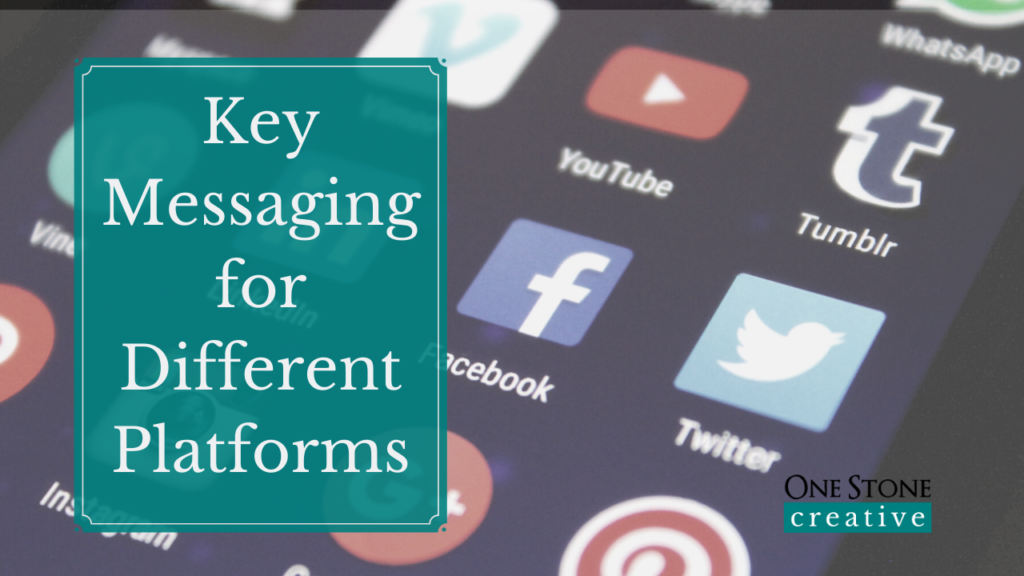Key Messaging on Different Platforms

Just like a clever farmer wouldn’t put all of her eggs in one basket, clever content marketers don’t put all of their business goals in one content platform.
Different platforms are great at different things, and people engage with them in different ways, and you should be using each platform to the best of its ability to serve you.
That means having slightly different content on each platform. Different types, different topics for different purposes.
But, you might be saying right now – I can’t have a different topic for each platform! The logistics would be ridiculous – there would be no scaling that effort!
Don’t worry – there’s an easy way to maintain consistency in your content calendar, and still serve the different people who are following you on different platforms.
You just need to identify the key message for each platform. This key platform message will become a lens you can look at ideas through to determine how to present them to your audience.
Let’s break that down a little more.
Let’s say you have a content mix that includes creating content for people at different phases of the customer lifecycle. You write blog posts for your current clients that are very informative, give them tools and strategies to make better use of your services, and understand the industry more as a whole.
For your hot leads – people who have been in your orbit for a while, and are serious about your products and services, you do livestreams to answer questions and concerns and have a course or membership community where you give them the kind of training and information that will help them be ready to work with you.
For potential leads and peers – the broader community who is aware of you, and that you’re cultivating a reputation with, you have a podcast where you have interviews with the movers and shakers in your space, a Youtube channel where you make arguments, give demonstrations and showcase product features, as well as other courses that help people get familiar with your area of expertise.
Each of these platforms should have a key message that sets the tone for all of the content you create for it – one that appeals to the segment of your audience it’s for.
The key message is less precise than a blog post-thesis, or a YouTube call to action – it’s more about the feeling you want your audience to have when they’re on that platform, consuming your work. It’s the image you want to convey – how you’re hoping to be perceived.
Let’s look at some possible key messages for each of the platforms we’ve just talked about.
For your customer-centric, industry-leading blog, the key message for everything you put on it could be “we have great expertise.” You want your blog readers to be sophisticated and look at you as a source of trustworthy, up to date information.
The key message of your livestream could be “we’re here to support you” and that’s the idea that your hot leads are going to get every time they tune on to get a question answered, or watch you explain how a system or process works.
Which Content Platform will be the best for your goals?
We’ve broken down the content platforms that are the most useful for different business goals – check it out!
The courses you have for both your hot leads and the broader community send the message that “you can do some of this on your own” – you’re a company that cares about the growth and development of your community, and you’re empowering them to take their own actions.
Your podcast filled with expert advice and insight from the titans of your industry is designed to send the key message that you have authority and influence in your space. You have access to interesting, important people, and can make their knowledge accessible to your audience.
Your Youtube channel, on the other hand, wants to send the message that ‘we’re real people, we’re relatable, we get the issues you’re having.” and when people watch it they feel like they know you, and you’re someone they could really work with.
There is no right or wrong key message for each platform – as long as you can take into account the NATURE of that platform, and how your audience is using it. You then use these key messages to communicate different aspects of one idea to the people who are going to most benefit from them.
Here is what developing a cross-platform campaign might look like when something really new and interesting happens in your industry:
You’ll have a blog post outlining what happened, and your company’s stance on it – with some strong examples of how it might impact your different kinds of clients.
Over on your livestream, you’ll prepare a talk and Q and A session for your hot leads about how this change will impact them personally, and how your company is positioned to help navigate that.
On your podcast, you’ll schedule and release an episode with a key player in your industry – someone who has deep and possibly inside knowledge about what caused this change and what the overall impacts are going to be, and you’ll also create a Youtube video tracking the timeline of this change – what happened when, and who was involved so the community at large will associate you with the real story of what went down.
Not every idea needs to go on every platform – but taking one concept, and massaging it so it serves the audience of the specific platforms you DO put it on, every idea you and your team have magnifies in value, and can do more work for your business.
And it’s much easier to keep track of!



